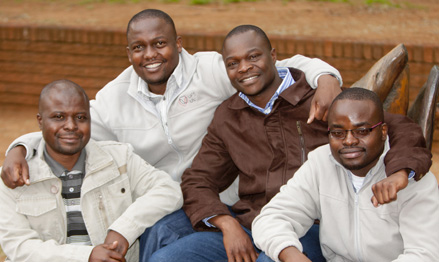|
 |
Noel Ndumeya, Tinashe Nyamunda, Ivo Mhike and Anusa Daimon
Photo: Hannes Pieterse |
The Centre of Africa Studies (CAS) has been recruiting the best young scholars from across the SADC region – with magnificent success. In the span of six months, four PhD students have excelled both on the African continent and abroad.
Anusa Daimon, Noel Ndumeya, Ivo Mhike and Tinashe Nyamunda – the names of these distinguished students. Set against the backdrop of global excellence and competition, they have been awarded several positions at conferences and already published world-wide.
Anusa Daimon’s PhD studies at the CAS focuses on Malawian migrants and their descendants in Southern Africa. It explores issues of identity construction and agency among this group.
Since his arrival at the CAS, Daimon has won two fully-funded awards to attend international conferences and workshops. He was invited to attend the Young African Scholars Conference at Cambridge University in the UK. He also went to Brazil to the IGK Work and Human Lifecycle in Global History Summer Academy. This workshop explored the historical and modern meanings and practices of work in terms of ‘freedom’ and ‘unfreedom’.
Noel Ndumeya holds a special interest in environmental history and the aspects of conservation and conflict. His PhD hones in on land and agrarian studies with specific focus on South Eastern Zimbabwe.
Ndumeya has won an award from the African Studies Association United Kingdom (ASAUK). This earned him an invitation to Nairobi, Kenya, to work with an editor from the Journal of Southern Africa Studies (JSAS).
Ivo Mhike’s research specialises in youth culture and their relationship with the state. In his PhD he uses juvenile delinquency as a window towards an analysis of social constructs of youth behaviour. This includes youth policy and their institutional and administrative links to the state.
Mhike has been invited to attend the CODESRIA Child and Youth Institute in Dakar, Senegal, with the theme: Social Protection and the Citizen Rights of Vulnerable Children in Africa.
Tinashe Nyamunda specialises in African Economic History. His PhD thesis is entitled, “The State and Finance in Rhodesia: A study of the evolution of the monetary system during the Unilateral Declaration of Independence (UDI), 1965–1979”.
Under the direction of his primary supervisor, Prof Ian Phimister and his secondary supervisor, Dr Andrew Cohen, four of his papers have been accepted for publication. Nyamunda also received sponsorship from the Rector’s Office for an edited book collection of which he is the leading author. The book focuses on the many aspects of Zimbabwe’s blood diamonds.
Recently, Nyamunda has contributed papers at conferences in Botswana and Scotland and attended a workshop at Lund University in Sweden. He has also received an invitation from Germany and Oxford to present some chapters of his PhD thesis.
“The centre has provided the best working environment any PhD student can dream of,” Nyamunda said. He continued to remark that the opportunities Prof Jonathan Jansen has created opened up immense possibilities for them.
“Given these fruitful experiences in just a year at the university,” Nyamunda said,” imagine what can be accomplished given the resources and environment availed by the institution.” The prospects after his PhD studies looks bright, he concluded, because of the opportunities provided by the UFS.